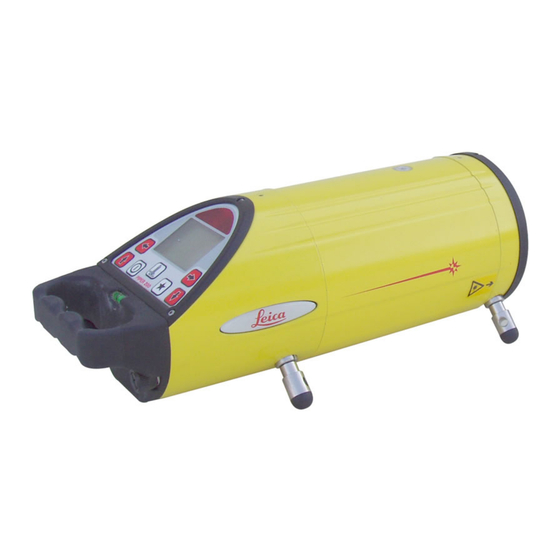
Table of Contents
Advertisement
Quick Links
Advertisement
Table of Contents

Summarization of Contents
Introduction
Purchase Information
Details the congratulatory message on purchasing the Leica Pipe Laser product.
Product Identification
Explains where to find the model and serial number on the product's type plate.
Manual Scope and Validity
Defines the manual's applicability to Piper 100/200 lasers and validity.
Supported Product Models
Lists the specific Piper Laser models covered by this manual.
Trademarks
Notes that product names are trademarks or registered trademarks.
Available Documentation
Lists additional documentation and resources for the Piper 100/200.
Safety Directions
General Safety Information
Provides general directions for anticipating and avoiding operational hazards.
Definition of Use and Misuse
Defines the intended use and reasonably foreseeable misuse of the product.
Limits of Use
Specifies suitable environments and limitations for the product's safe operation.
Responsibilities
Outlines the responsibilities of the manufacturer and the product user.
Lifetime Manufacturer’s Warranty
Details the warranty coverage and terms for the Piper 100/200.
Hazards of Use
Identifies potential hazards during operation and necessary precautions.
Laser Classification
General Laser Safety
Explains general laser safety standards and product classifications.
Piper 100 (Class 3R) Safety
Details laser classification, hazards, and precautions for Piper 100 (Class 3R).
Piper 100 (Class 2M) Safety
Details laser classification, hazards, and precautions for Piper 100 (Class 2M).
Piper 100G/3 (Class 3R) Safety
Details laser classification, hazards, and precautions for Piper 100G/3 (Class 3R).
Piper 100G/2 (Class 2M) Safety
Details laser classification, hazards, and precautions for Piper 100G/2 (Class 2M).
Piper 200 (Class 3R) Safety
Details laser classification, hazards, and precautions for Piper 200 (Class 3R).
Piper 200G (Class 3R) Safety
Details laser classification, hazards, and precautions for Piper 200G (Class 3R).
Care and Transport
Transport Procedures
Guides on transporting the equipment in the field, vehicles, and via shipping.
Storage Guidelines
Provides instructions for storing the product, including temperature limits.
Cleaning and Drying
Details the correct procedures for cleaning and drying the product and accessories.
Technical Data
General Product Specifications
Covers operating range, accuracy, dimensions, weight, and battery life.
Environmental Specifications
Lists operating and storage temperature, and protection against water/dust.
Regulatory Conformity
Declares compliance with relevant national and European regulations.
Description of the System
Key Product Features
Highlights the main features and benefits of the Piper laser.
Piper Components Overview
Identifies and describes the main components of the Piper unit.
Case Components Overview
Identifies and describes the components included in the product case.
Basic Operation
Starting Up the Piper
Step-by-step guide to powering on the Piper and initial screen displays.
LCD Display Explanation
Explains the icons and indicators shown on the Piper's LCD screen.
Control Buttons Functions
Details the function of each button on the Piper unit and its remote control.
Setting Grade, Elevation, and Line
Defines and explains how to set the essential operating parameters: grade, elevation, and line.
Entering and Changing Grade
Provides detailed instructions for setting and modifying grade values.
Changing Line Position
Guides on how to adjust the line position and reset it to the center.
Line and Grade Lock
Explains how to lock and unlock the grade and line settings.
Alignmaster Function
Describes the Alignmaster feature available only on Piper 200 models.
Alignmaster Procedure
Step-by-step guide on how to use the Alignmaster function.
Alignmaster Troubleshooting
Lists common issues with Alignmaster and their solutions.
Standard Setup Procedures
Setup for Pre-Poured Inverts
Instructions for setting up the Piper in pre-poured inverts using a transit.
Setup In or On Top of Pipe
Procedures for placing and aligning the Piper on or inside pipes.
Open Trench Setup (Stringline)
Setup method for open trenches using a stringline alignment.
Manhole Setup Procedures
Steps for setting up the Piper within manholes and drop manholes.
Over the Top Setup
Guide for setting up the Piper using the Over-the-Top Mount Assembly.
Refraction
Impacts of Refraction
Explains how temperature and humidity affect laser beam path.
Counteractive Measures for Refraction
Details how to use a blower assembly to mitigate refraction effects.
Accessories
Target Assembly Details
Describes the Target Assembly and its role in locating the laser beam.
Remote Control Functions
Explains the operation and buttons of the remote control unit.
Trivet Assembly Components
Identifies and describes the parts of the Trivet Assembly.
Self-Centring Feet
Details the function and different sizes of self-centring feet.
Lithium-Ion Battery
Information on the Piper's lithium-ion battery, including removal and installation.
Battery Charging and Operation
Instructions for charging and operating the lithium-ion battery.
Accuracy Adjustment
Checking and Adjusting Accuracy
Guidance on periodically checking and adjusting instrument accuracy.
Checking Level Accuracy
Step-by-step procedure to verify the level accuracy of the Piper.
Accessing Adjustment Screen
Instructions on how to enter the instrument's accuracy adjustment mode.
Adjusting Level Accuracy
Method for adjusting the Piper's level accuracy based on error checks.
Exiting Adjustment Screen
How to save adjustments and return to the main operating screen.
Checking Line and Grade
Checking Line and Grade Procedure
Procedure to verify pipe alignment and grade after initial laying.
Determining Actual Pipe Grade
Method for calculating the actual grade of the laid pipe.
Comparing Measured vs. Dialed Grade
Compares the actual pipe grade with the grade set on the Piper.
Troubleshooting
Common Display Issues and Solutions
Lists common display symptoms and their potential causes and solutions.













Need help?
Do you have a question about the Piper 200G and is the answer not in the manual?
Questions and answers